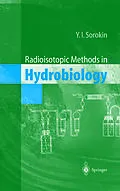Written in a didactic way so as to stimulate thought and discussion, this is a comprehensive description of all devices helpful in radioisotopic techniques. Despite being exhaustive in its coverage, this handbook will navigate researchers and students through the numerous techniques available to find those that are most suitable and reliable. The author has 50 years experience in this field and so is able to offer evaluations and instructions for practical use. The methods described are illustrated by tables and graphs with all the relevant results.
Inhalt
1 General Features of Radioisotopic Methodology and Measurement of Radioactivity.- 1.1 Physical Background.- 1.2 Measurement of Radioactivity.- 1.2.1 General Considerations.- 1.2.2 Liquid Scintillation Counting.- 1.2.2.1 Basic Principles.- 1.2.2.2 Practical Use of Liquid Scintillation Counting.- 1.2.2.3 Quenching and Quench Correction.- 1.2.2.4 The Effect of Chemoluminescence.- 1.2.3 Application of Radioisotopic Methods in Hydrobiology.- 2 The Radiocarbon Method to Estimate Primary Production in Aquatic Environments.- 2.1 Introduction.- 2.2 Historical Proceedings.- 2.3 Technique of Measuring Phytoplankton Primary Production.- 2.3.1 General Principles.- 2.3.2 Practical Use of the 14C-Methodology to Estimate Cps.- 2.3.2.1 Preparation of 14C-Carbonate Working Solution and Determination of its Radioactivity (Ri).- 2.3.2.2 Estimation of Total Hydrocarbonate Carbon Contents in Water (Ci).- 2.3.2.3 Selection of Bottles for Experiments and Their Preparation.- 2.3.2.4 Sampling Technique.- 2.3.2.5 Experiments to Measure the Absolute Photosynthesis Rate (Cp) and Primary Production (Cps) in the Surface Water Layer.- 2.3.2.6 Practical Problems of Filtration and Measuring Radioactivity of Filters.- 2.3.2.7 Estimating correction Coefficients (Kl,Kc).- 2.3.3 Estimating Integrated Pelagic Primary Production in the Water Column (Cpt).- 2.3.3.1 The Cpd Method.- 2.3.3.2 Ks Calculative Method.- 2.3.3.3 Conversion from Daily Rates to the Whole Basin and Annual Primary Production.- 2.4 Faults in the Radiocarbon Method and Problems in its Calibration.- 2.5 Use of the Radiocarbon Method to Determine Primary Production by Benthic Hydrophytes and Their Associations.- 2.5.1 General Principles in the Use of 14C - Methods.- 2.5.2 Experimental Vessels and Enclosures.- 2.5.3 Preparation of Working Solution of 14C - Carbonate.- 2.5.4 Incubation Procedures.- 2.5.5 Estimation of Radioactivity in Plant Material.- 2.5.6 Calculation of Results; Comparison with Alternative Methods.- 3 Radioisotopic Methods for the Study of Nutrition in Aquatic Animals.- 3.1 Introduction. Alternative Methods.- 3.2 General Principles.- 3.3 Preparation of Labeled Food.- 3.3.1 Labeling Algae and Plant Detritus.- 3.4 Analyses of Basic Values Needed for the Calculation of Intensity and Efficiency of Nutrition.- 3.4.1 Estimation of Cr.- 3.4.2 Determination of Radioactivity in Consumers' Bodies (Ra).- 3.4.3 Determination of Radioactivity of Respired CO2 and Feces.- 3.4.4 Estimation of the Inverse Specific Radioactivity of CO2 Respired by Labeled Animals (Cq).- 3.5 Use of 14C for Assessment of Nutritional Problems in the Ecology and Physiology of Aquatic Animals.- 3.5.1 Assessing the Duration of Digestion.- 3.5.2 Assessing Comparative Rates of Food Ingestion and Assimilation.- 3.5.3 Radiocarbon Estimation of the Relative Rate of Respiration.- 3.5.4 Evaluation of Food Spectrum and Selectivity.- 3.5.5 Dependence of Nutrition Rate upon Food Concentration.- 3.5.6 Experimental Evaluation of Other Factors Influencing Nutrition Rate.- 3.5.7 Determinating Filtration Rates in Filter Feeders.- 3.5.7.1 General Considerations.- 3.5.7.2 Technique for Fr Determination.- 3.6 Measurements of Absolute Rates of Feeding, Food Assimilability, and Respiration.- 3.6.1 General Considerations.- 3.6.2 Technique of the Balance Experiment.- 3.6.3 Estimations of Aquatic Animal Nutrition with Dissolved Organic Matter.- 3.6.3.1 General Remarks.- 3.6.3.2 Technique for Measurement of DOM Uptake.- 3.6.4 Radiocarbon Method of Measurement of Absolute Rates of Respiration.- 3.7 Concluding Remarks.- 4 Use of Radioisotopic Methodology in Aquatic Microbial Ecology.- 4.1 Introduction.- 4.2 Estimation of Relative Microbial Activity in Aquatic Habitats.- 4.2.1 General Remarks.- 4.2.2 The Technique of Microradioautography.- 4.2.3 A Study of the Spatial Distribution of Metabolically Active Heterotrophic Microbial Populations.- 4.2.3.1 General Remarks.- 4.2.3.2 Practical Implementation.- 4.3 Determination of the in situ Decomposition Rates.- 4.3.1 General Remarks.- 4.3.2 Practical Implementation.- 4.4 Determination of Microbial Production.- 4.4.1 Introduction.- 4.4.2 Application of 14CO2 Dark Uptake for Estimation of Heterotrophic and Chemoautotrophic Microbial Production.- 4.4.2.1 Introduction.- 4.4.2.2 Measuring Production of Heterotrophic Bacteria.- 4.4.2.3 Estimating Chemosynthetic and the Overall Bacterial Production in the Redox Zones Within the Water Column.- 4.4.2.4 Determination of Anoxygenic Bacterial Photosynthesis.- 4.4.3 The Thymidine Method.- 4.4.3.1 General Considerations.- 4.4.3.2 Practical Procedure.- 4.4.3.3 Measuring Bacterial Production in Bottom Sediments.- 4.4.4 The Labeled PO4P - Uptake Method.- 5 Use of Radioisotopes to Study Biogeochemical Cycling of Elements in Aquatic Environments.- 5.1 Introduction.- 5.2 Study of Microbial Methane Oxidation Using 14C.- 5.2.1 General Remarks.- 5.2.2 Practical Procedures.- 5.3 Estimation of in situ Methane Production Rates.- 5.4 Measurement of Nitrification Rate with the 14CO2 Dark Uptake Method.- 5.5 Studying Sulfur Cycling with the Aid of 35S.- 5.5.1 Introduction.- 5.5.2 Measuring the Rate of Sulfide Oxidation.- 5.5.2.1 Preparation of the Working Solution of Labeled Sulfide.- 5.5.2.2 Experimental Procedure.- 5.5.3 Oxidation Rates of Thiosulfate and Elemental Sulfur.- 5.6 Study of Sulfate Reduction.- 5.6.1 General Remarks.- 5.6.2 Practical Implementation: Bottom Sediments.- 5.6.2.1 Preparation of the Working Solution of Labeled Sulfate.- 5.6.2.2 The Slurry Method.- 5.6.2.3 The Core Method.- 5.6.3 Practical Implementation: Water Column.- 5.6.4 Location of Active Populations of Sulfate-Reduction Bacteria.- 5.7 Study of the Dynamics of Phosphorus.- 5.7.1 General Remarks.- 5.7.2 Measuring PO4P Uptake Rates by Microplankton.- 5.7.2.1 Preparation of the Isotope Working Solution.- 5.7.2.2 Estimation of the Total PO4-P-Uptake by Microplankton.- 5.7.3 Estimation of the Share of Bacterioplankton in Total PO4-P Consumption by Microplankton.- 5.7.4 Estimation of in situ PO4-P Regeneration Rates.- 5.7.5 Consumption of PO4-P from the Water Column by the Elements of Bottom Biotopes.- 6 Assay of Some Common Hydrobiological Techniques.- 6.1 Techniques for the Quantification Density of Microplankton Populations.- 6.1.1 Phytoplankton.- 6.1.2 Heterotrophic Microplankton.- 6.1.2.1 Bacterioplankton.- 6.1.2.2 Nanoheterotrophs.- 6.1.2.3 Planktonic Ciliates.- 6.1.2.4 Multicellular Microzooplankton.- 6.2 Quantification of Mesozooplankton.- 6.3 Total Plankton Respiration, Stock of Labile Organic Matter, and its Turnover Time.- 6.4 Determination of Free H2S and Labile Sulfides in Bottom Sediments.- 6.5 Conclusion.- References.
